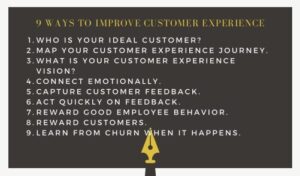What would the impact be if you could improve customer experience in your business?
How would making ongoing improvements in this area affect your ability to get more customers?
According to a recent PwC study, 86% of people who have an exceptional customer experience buy again.
Let that settle in for a second…
Not only would they buy again, but they would become loyal, raving fans of your business.
Fans that are ready to tell the world about their great experience, and quite likely provide you with a flood of referrals.
Notice, then, how our thoughts change from “why bother?” to “how can I?”
Well, let’s start by having a look at how you can improve your customers’ experience in your business.
What Is Customer Experience?
Customer experience, CX for short, is the interaction your customers have with your company and its people, products, and services.

Think about your customers’ experience as having three different pyramids that need to be mastered. Each of which you need to consider if you want to figure out how to improve.
1. The expectations they have before they come into contact with your business.
It’s rare that a customer will come into contact with your business without first having some sort of expectation. Possibly they’ve visited a competitor’s business previously, or maybe they’ve heard about your business through a referral.
If you advertise, you are essentially creating some first impressions that your customer will expect when they come into contact with your business.
2. The experiences they have when they are interacting with your business
When your customer actually visits your business, be it in person at a brick-and-mortar location, or online, what is their experience?
How are they first greeted or welcomed? Does it align with their expectations, or is it an even better experience?
Does the experience elicit feelings of satisfaction (it meets or exceeds their expectations), or are they confused or even frustrated at the gap between what they expected and what they received?
3. How they feel after they’ve interacted with your business.
Once a customer has left your business, how do they feel? Were their expectations met or did they leave unsatisfied?
Do you connect with customers after their visit to your business to thank them in some way for their time and patronage?
The after-effects of a customer’s experience can ultimately determine whether they visit your business again, and the extent to which they will share their experience.
This is also an opportunity to salvage the relationship in the event that their experience was not as they had expected.
But Isn’t Customer Experience the Same as Customer Service?

It’s not uncommon for the term customer experience to be confused with customer service. The terms are related, however, customer service is how you are treated during an interaction, whereas customer experience looks at the entire experience.
For example, let’s say you ask a grocery clerk where to find the mustard. The kid quickly shrugs you off and responds with, “I dunno.”
That’s poor customer service.
Let’s say you’ve been visiting that grocery store for years. Generally, you’ve been happy with the product selection and don’t have any other complaints. In this instance, then, you wouldn’t say you’ve had a bad customer experience, but rather you experienced bad customer service.
Another way to think about the difference between the two terms is that customer service exists as part of your customer experience.
The Comeback
When we moved homes several years ago, I had booked our local internet company to hook up our internet connection. On the day they were to come, two gentlemen arrived (late, I might add) to install the wiring and modem.
They were quick to realize that they didn’t have a connector that would be needed, and when I asked if they could go to get one, they responded that they were on a tight schedule.
They left in a hurry, presumably to get to their next appointment, however, remained parked in front of our house. After 15 minutes, I decided to go out and see what the problem was.
There wasn’t a problem. They were parked talking to a coworker who had pulled up across the street.
My wife and I were understandably upset and called the company to reschedule the install, sharing my story.
Several hours later, I was called by a customer service agent who had learned of our experience. She spent nearly twenty minutes listening to my story, and then in turn went on to apologize, reschedule our appointment, and reassure us there would be no charges due to the inconvenience.
A different gentleman arrived the next day to install the internet, without issue, and within 30 minutes was on his way.
I can honestly say that if it wasn’t for the employee who contacted us to listen, be empathetic, and resolve our issue, we would never have stayed with that company.
Lessons learned from a bad customer experience can be be shared to improve customer experience. Ensure you don’t make the same mistake twice.
Is Customer Experience Important?

So then just how important is customer experience? If you improve customer experience, is it worth it?
A recent article in Forbes referenced 50 key stats that prove exactly why a positive customer experience is important. A couple of points that stand out include the following:
- 84% of companies that work to improve their customer experience report an increase in their revenue.
- 96% of customers say customer service is important in their choice of loyalty to a brand.
Needless to say, investing time and effort into ensuring a positive customer experience can pay dividends.
If the stats don’t have much meaning to you, though, consider your own customer experiences.
It’s likely that when you’ve had a good customer experience, you’ve returned to buy or frequent the establishment again. So repeat business is an obvious benefit.
Additionally, you’ve likely shared or recommended the product or service to your friends. Referral marketing, as this is referred to, is one of the most powerful methods to attract new customers.
By sharing your own positive customer experience, and recommending friends visit the establishment, you create new business leads for that business.
Moreover, you do so much faster and at less of a cost than the business could have generated themselves.
Nine Ways to Improve Your Customer’s Experience

1. Who Is Your Ideal Customer?
It goes without saying that the starting point of creating a positive customer experience is understanding who your ideal customers are.
You can’t cater to everyone, so consider the demographic of your ideal customer (their age and gender, if applicable). What does their day look like? How does your product or service fit into their day? What do they need from your product or service?
2. Have a Plan: Map Your Customer’s Journey
It’s pretty difficult to have a strong customer experience if you don’t first understand what the experience looks like. By creating or mapping out your customer experience journey, you can quickly identify weaknesses or areas for improvement.
3. What’s Your Vision for Your Customer’s Experience?
Once you’ve identified exactly who your desired customers are, and what your existing experience looks like, what are the gaps? By mapping out exactly what you think would equate to an exceptional customer experience for your ideal customer, you can easily identify where improvements or changes are necessary.
4. Connect Emotionally: How Does the Experience Make Your Customer Feel?
Much of experience is emotion. My mentor a long time ago suggested to me that logic makes people think, but emotion makes them act.
You might have the most logical product or service to suit the needs of your ideal customer, but if there is no emotional connection, the experience will be weak.
How would your customers describe their journey? Would they use words that suggest positive feelings?
“The person who helped me seemed very friendly.”
“He smiled and told me to have a nice day.”
“Everyone who works there treats you like family.”
All of these statements suggest an emotional connection the customer has to their experience.
5. Capture Customer Feedback: Improvement Requires Data
Once you’ve mapped out and introduced improvements in your customers’ experience, you’ll need to determine exactly how you can monitor the impacts.
By finding ways to capture customer feedback, you can make improvements to your customers’ experience in real-time.
Maybe you introduce a survey after their visit. You could always have someone who thanks them for coming and asks about their experience. The point is, if you can quickly determine what changes are working and where further improvement is necessary, you’ll be able to ensure the best possible experience.
6. Act upon Feedback: Steady Improvement Requires Action
Presuming you’ve found a way to collect feedback, you’ll need to act on it and fast. Studies have shown that customer feedback is often a lagging indicator of a problem. By the time a customer tells you about a problem, dozens of other customers have already experienced it.
Putting daily reviews in place or setting up teams to collect customer feedback is crucial. More importantly, having a plan to act on feedback to improve customer experience is even more important!
You don’t want to overreact and change things just because someone doesn’t like them. Alternatively, though, by reviewing feedback in real-time, you’ll quickly see patterns and problems emerge.
I suggest clients use the R.D.R. approach to their customer feedback:
Review: Set up protocols to review feedback frequently.
Discuss: Have a team of people from different areas that discusses the feedback to identify solutions.
Respond: Act quickly to introduce changes when patterns emerge.
7. Reward Good Behavior: Encourage Positive Customer Experience Delivery
To ensure employees are always trying to provide a positive customer experience, recognize and reward the right behaviors.
A recent study by Cornell University Researchers suggests that frequent employee rewards reinforce positive and desirable behaviors.
So if an employee does anything that supports your customer experience vision, reward them. More importantly, make sure others know that they are being provided a reward and why. This serves to ensure others recognize what behaviors are rewarded, leading them to strive for similar behavior.
It goes without saying that not all employees are motivated by the same rewards, so change up what you offer. From gift cards to time off, to teaching other employees how they delivered the desired behavior, varying rewards will ensure the broad team is incentivized.
8. Reward Customers: Measure the Impact of Delivering a Great Customer Experience
If you have customers who are loyal, dedicated, or even just fun to work with, don’t forget to reward them as well! By rewarding your “best” customers, you can create a sort of club that others will strive to belong to.
Consider customer loyalty programs like the one DSW, a shoe manufacturer, runs. They provide points with each purchase that both reward customers for buying and incentivize them to invest the points in future purchases.
Another idea is to provide surprise bonuses to customers when they reach certain spend levels, or send gift cards or thank-you cards for being a loyal customer.
The sky’s the limit; however, the key is to make sure every customer who is loyal and aligns with your ideal customer traits is rewarded.
9. Learn from Churn When it Happens
When a customer fails to return to buy from you, do you know why? Rewarding customers requires that you find a way to monitor customer activity, starting with when and how often they frequent your business.
This very same data can identify if a customer falls off and stops buying at the same frequency they did previously.
When a customer hasn’t returned for a period long enough that you deem them to be a “lost customer”, finding out why becomes critical to ensuring you can continue to improve the customer experience.
Reaching out to connect with customers through direct mail, email, or even social media is a way to stay in touch and inquire about when their next visit may be. Taking this opportunity to understand why they haven’t visited you in a while is important, as it feeds your ability to improve customer experience for everyone.
Reap the Benefits of Your Investment

It takes so much effort, time, and money to attract and sell to a new customer, the last thing you need is for the customer to leave as a result of a bad experience.
Not only have you lost the ongoing revenue, but you have to start all over again to try and replace them!
Fortunately, however, the solution is simple. Put as much effort into ensuring every customer has a positive experience as you do in getting the customer in the first place.
By just following and applying the nine steps above, not only can you provide a positive customer experience, but you can generate more new customers! All without spending any time or money in finding them.
How?
Customers that repeatedly have a positive experience are more likely to refer others to you.
Moreover, customers who are raving fans will invest more money with you, providing new up-sell opportunities.
If you want to take the shortest path possible to building and scaling your business, you need to focus on providing a positive customer experience.
It’s that simple.
Frankly, the alternative is too costly and too stressful.
© Shawn Casemore 2022. All Rights Reserved.




Share This Article
Choose Your Platform: Facebook Twitter Google Plus Linkedin